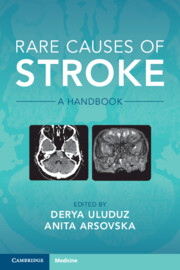Book contents
- Rare Causes of Stroke
- Rare Causes of Stroke
- Copyright page
- Contents
- Contributors
- Preface
- 1 Inflammatory Conditions
- Chapter 1.1 Isolated Vasculitis of the Central Nervous System
- Chapter 1.2 Primary Systemic Vasculitis
- Chapter 1.2 Chapter
- Chapter 1.3 Vasculitis Secondary to Systemic Disease
- 2 Infectious and Postinfectious Vasculitis
- 3 Hypercoagulable Causes of Stroke
- 4 Drug-Related Stroke
- 5 Hereditary and Genetic Causes of Stroke
- 6 Rare Causes of Cardioembolism
- 7 Vasospastic Conditions and Other Vasculopathies
- 8 Other Non-inflammatory Vasculopathies
- 9 Venous Occlusive Conditions
- 10 Bone Disorders and Stroke
- Index
- References
Chapter 1.2 - Chapter
from 1 - Inflammatory Conditions
Published online by Cambridge University Press: 06 October 2022
- Rare Causes of Stroke
- Rare Causes of Stroke
- Copyright page
- Contents
- Contributors
- Preface
- 1 Inflammatory Conditions
- Chapter 1.1 Isolated Vasculitis of the Central Nervous System
- Chapter 1.2 Primary Systemic Vasculitis
- Chapter 1.2 Chapter
- Chapter 1.3 Vasculitis Secondary to Systemic Disease
- 2 Infectious and Postinfectious Vasculitis
- 3 Hypercoagulable Causes of Stroke
- 4 Drug-Related Stroke
- 5 Hereditary and Genetic Causes of Stroke
- 6 Rare Causes of Cardioembolism
- 7 Vasospastic Conditions and Other Vasculopathies
- 8 Other Non-inflammatory Vasculopathies
- 9 Venous Occlusive Conditions
- 10 Bone Disorders and Stroke
- Index
- References
Summary
A 17-year-old female was referred with a history of several neurological episodes with seizures, sudden vision loss and transient right- and left-sided hemiparesis over 3 years. Increased acute phase reactants have been associated with these episodes. A presumptive diagnosis of vasculitis was established after detection of fever, myalgia, abdominal pain, livedo reticularis and severe hypertension at last episode. On admission, she was febrile (38.3 °C) and her blood pressure was 170/110 mmHg. Physical examination revealed livedo reticularis on both lower and upper limbs with a normal neurologic and fundoscopic examination. Diffuse muscle tenderness and colicky abdominal pain without rebound tenderness were also observed. Cranial angiography was normal, however higher signal intensity in bilateral parietal regions accompanied by parenchymal volume loss was observed in brain magnetic resonance imaging (MRI). Further investigation with conventional visceral angiography elicited multiple microaneurysms and segmental narrowings in branches of renal, hepatic and mesenteric arteries suggestive of a vasculitis affecting primarily medium-sized arteries. The patient diagnosed with polyarteritis nodosa (PAN) and all of the clinical manifestations including fever, myalgia, abdominal pain and hypertension have resolved by three types of antihypertensive medications and 5 days of pulse methylprednisolone (1 gr/m2/day). At discharge, oral methylprednisolone at a dose of 1 mg/kg/day and monthly intravenous cyclophosphamide infusions (1 gr/m2/month) for 6 months were planned for induction treatment. The patient no longer required antihypertensive medication by the second month of discharge and never had a recurrence of disease
Keywords
- Type
- Chapter
- Information
- Rare Causes of StrokeA Handbook, pp. 24 - 27Publisher: Cambridge University PressPrint publication year: 2022

